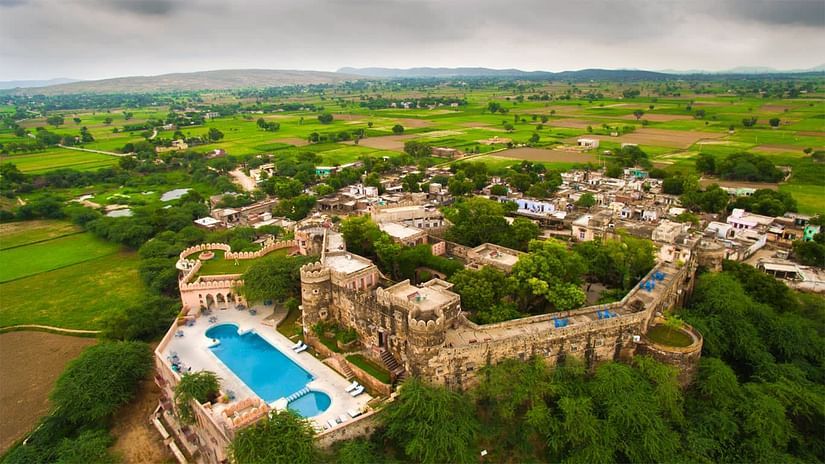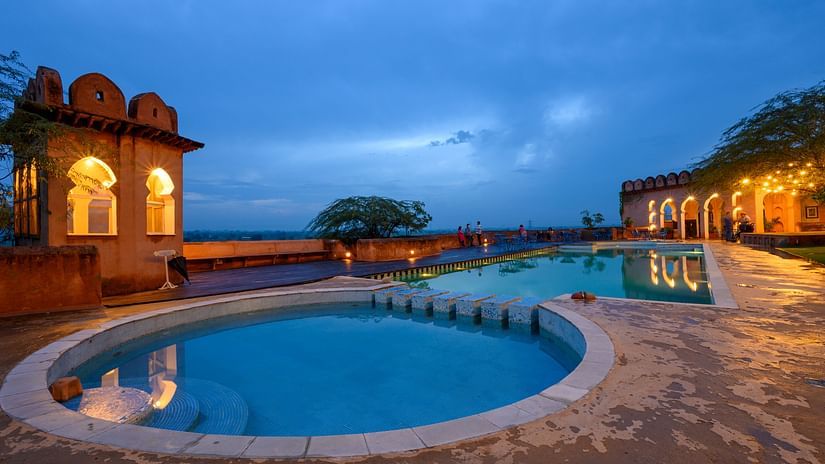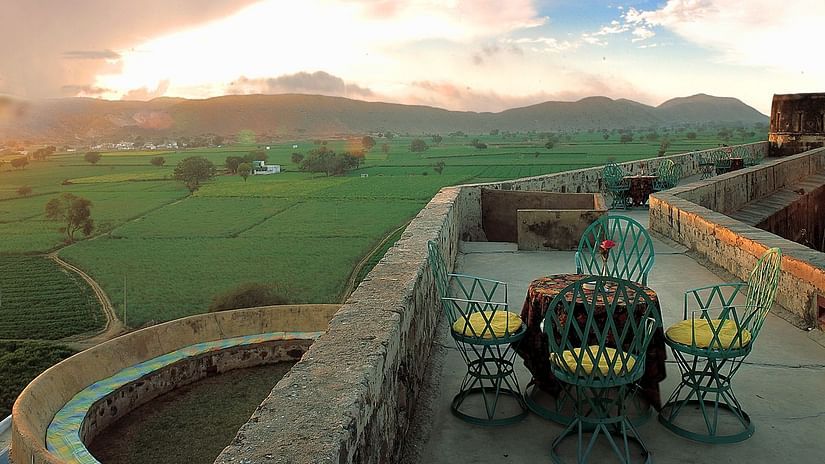Alwar, Rajasthan
The 14th century Hill Fort-Kesroli is one of the oldest heritage sites in India where one can stay. Sited atop the rare, dark Hornstone Breccia rocks, it commands splendid agrarian views from its ramparts. Kesroli makes an ideal base to visit the neighbouring palaces, museums, natural sites and sanctuaries of Alwar and Sariska.


The origins of the seven-turreted Hill Fort-Kesroli are traced back to over seven centuries. It saw its golden period under the Ranawat Thakur Bhawani Singh (1882-1934) who was renowned for his equestrian skills. Nestled amidst the ancient lands of the erstwhile Alwar State, lies Kesroli, a destination rich in history and steeped in the legacy of the Yaduvanshi kings. Since 1000 C.E., the region of Alwar was a part of Matsya kingdom known as Matsya Janapada, named after the illustrious Raja Matsil who claimed descent from the family of Lord Krishna.
Surrounded by the majestic two-billion year old Aravalli hills, Alwar has always been famed for its forts, stepwells, and its lush green countryside, evoking the curiosity of every traveller.
One such historical gem is Neemrana’s Hill Fort–Kesroli, located just 10 kilometers north-east of Alwar city and four kilometers from the Bharatpur road. Built approximately 700 years ago during the 14th century by the Yaduvanshi kings, the Kesroli Fort served as a formidable stronghold to ward off attackers marking the beginning of the Mewat region.
Over the centuries, the terrain of the Matsya region saw the rule of various Rajput clans, including the Nikumbh Rajputs, Chauhans, Kachchwahas, and eventually the Khanzadas who ruled the region for approximately 200 years. Khanzadas were Yadavas whose ancestor Sambharpal Yadav adopted Islam during the reign of Firuz Shah Tughlaq(1351-1388) who ruled over the Delhi Sultanate. Sambharpal's ancestor was Shri Krishna's son Praduman who had ruled over Bayana. Sambharpal was re-named Bahadur Nahar by Firuz Shah Tughlaq and handed over a lot of regions surrounding Delhi.
Bahadur Nahar established his supremacy over the entire Mewat region, with Khanzada Zakaria Khan’s son Alawal Khan becoming the ruler of Mewat in 1492 who captured land of the Nikumbha Rajput’s near Alwar. The Khanzadas' influence extended to various centres in Rajasthan, including Tijara, Kotla, Indok, Alwar, Dadhikar, Kesroli, and Bahadurpur, with Kesroli Durg serving as a vital fort for the security of Alwar. Bahadur Nahar divided the entire area among his nine sons in which Aklim Khan got the area surrounding the Alwar region. His dynasty was always in conflict with the Sultans of Delhi who had built many forts for their security. In which Neemrana’s Hill Fort-Kesroli,Alwar was strategically prominent.
In the late 15th century from 1448-85, under the rule of Zakariya Khan, Mewat witnessed close ties with the Lodi dynasty of Delhi fighting alongside Ibrahim Lodi in the battle of Panipat. Alawal Khan's involvement in the first battle of Panipat alongside Ibrahim Lodi. Mewat’s memorable ruler was his son, Hassan Khan Mewati, who gave the region its name. The restoration process started in 1995 and our resort in Kesroli was opened to guests in 1998. Its interior gardens- both in the Mardana and the Zenana quarters are refreshing and intimate, framing the tent of the sky above.
Through the annals of time, Hill Fort-Kesroli has stood as a testament to Indian heritage, reflecting the rich tapestry of Alwar's history. Today, it continues to enchant visitors with its timeless architecture, inviting guests to immerse themselves in the legacy of Rajasthan's past.


The Neemrana restoration philosophy of not overdoing the re-vamping exercise for use as a ‘non-hotel’ keeps its architecture as original and authentic as any film director would like. Between the exteriors and interiors of one of the Kesroli resorts, a host of patinas, furnishes and backdrops can be found, besides a variety of furniture both indigenous and colonial with authentic period props.